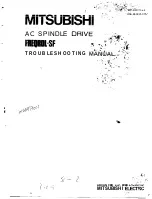
D
D
C
C
S
S
3
3
0
0
3
3
D
D
i
i
g
g
i
i
t
t
a
a
l
l
D
D
C
C
S
S
e
e
r
r
v
v
o
o
D
D
r
r
i
i
v
v
e
e
r
r
M
M
a
a
n
n
u
u
a
a
l
l
R
R
e
e
v
v
1
1
.
.
0
0
Tel: (86)755-26434369
12
Website: www.leadshine.com
ground loops, which are a frequent source of noise. Central point grounding should
also be applied to cable shielding; shields should be open on one end and grounded
on the other. Close attention should also be given to chassis wires. For example,
motors are typically supplied with a chassis wire. If this chassis wire is connected to
PE, but the motor chassis itself is attached to the machine frame, which is also
connected to PE, a ground loop will be created. Wires used for grounding should be
of a heavy gauge and as short as possible. Unused wiring should also be grounded
when safe to do so since wires left floating can act as large antennas, which
contribute to EMI.
Power Supply Connection
NEVER
connect power and ground in the wrong direction, because it will damage
the DCS303 driver. The distance between the DC power supply of the drive and the
drive itself should be as short as possible since the cable between the two is a source
of noise. When the power supply lines are longer than 50 cm, a 1000
µ
F/36V
electrolytic capacitor should be connected between the terminal
“
GND
”
and the
terminal
“
+VDC
”
. This capacitor stabilizes the voltage supplied to the drive as well
as filters noise on the power supply line.
Please note that the polarity can not be
reversed.
It is recommended to have multiple drivers to share one power supply to reduce cost
if the supply has enough capacity. To avoid cross interference,
DO NOT
daisy-chain
the power supply input pins of the drivers. Instead, please connect them to power
supply separately.
5. Tuning the servo
Testing the servo
You may wish to secure the motor so it can
’
t jump off the bench. Turn on the power
D
D
C
C
S
S
3
3
0
0
3
3
D
D
i
i
g
g
i
i
t
t
a
a
l
l
D
D
C
C
S
S
e
e
r
r
v
v
o
o
D
D
r
r
i
i
v
v
e
e
r
r
M
M
a
a
n
n
u
u
a
a
l
l
R
R
e
e
v
v
1
1
.
.
0
0
Tel: (86)755-26434369
13
Website: www.leadshine.com
supply, the green (Power) LED will light. The DCS303 has default parameters
stored in the driver. If the system has no hardware and wirings problem, the motor
should be locked and the driver should be ready.
If the motor jumps slightly and the red LED immediately turns on (flickers), then
either the motor or the encoder is wired in reversal. Open the tuning software
ProTuner and check driver status by clicking
Err_check
. If it
’
s
Phase Error
, then
reversal motor wires or exchange encoder inputs and try again. If it
’
s
Encoder
Error
, please check encoder and its wirings, and then try again. If it still doesn
’
t
work after you followed all of the previous steps, please contact us at
If the red LED is off and the motor is normal, then you can start to tune the servo
with selected tool.
ProTuner
and
STU
are available for the DCS303.
Tuning the Servo
A servo system is error-driven. The
“
Gain
”
of the system determines how hard the
servo tries to reduce the error. A high-gain system can produce large correcting
torques when the error is very small. A high gain is required if the output is required
to follow the input faithfully with minimal error.
A servo motor and its load both have inertia, which the servo amplifier must
accelerate and decelerate while attempting to follow a change at the input. The
presence of the inertia will tend to result in over-correction, with the system
oscillating beyond either side of its target. It
’
s called UNDER DAMPED status. See
Figure 5-1. This oscillation must be damped, but too much damping will cause the
response to be sluggish, namely cause the system to get into an OVER DAMPED
state. When we tune a servo, we are trying to achieve the fastest response with little
or no overshoot, namely get a CRITICALLY DAMPED response.










































